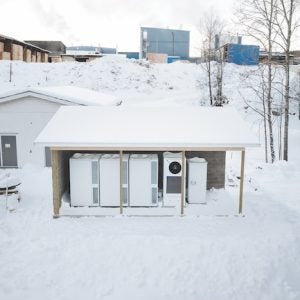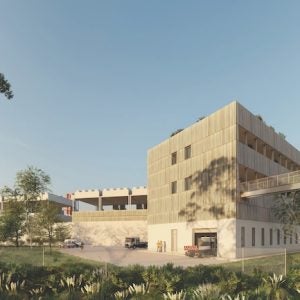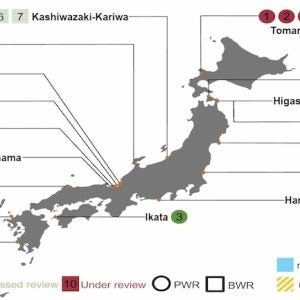Net plant thermal efficiency may be the key to profitable IPP operation, but the last thing that the utility gas turbine market needs now is a race to reach the highest power output figures at the expense of availability, maintainability or reliability.
Few generation plant financers or developers today will even consider new highly rated prime movers without clear demonstration of in-service reliability, durability and low maintenance cost potential.
Large gas turbine manufacturers are taking major equity stakes and carrying technical risk liabilities in first-of-a-kind IPPs. ABB (now Alstom) built a full size test and development power generation plant for the newest 50 Hz machines (see description of Birr GT26 research and test plant in the May 1997 MPS).
These first field test plants tend to depend on some form of power sales agreement for revenue and are financed on the balance sheets of sponsoring utilities. The Enfield Energy Centre in north-east London, at Enfield Locks on the River Lee, is a project financed merchant IPP, which benefits from all of the field testing and wealth of development experience on the GT26 gas turbine to date.
The gas turbine unit at Enfield is referred to as the GT26B, which has a substantially increased output compared to the earlier GT26A that has been installed elsewhere. The nominally 400 MWe single shaft KA26-1 combined cycle plant, which is based on the Taranaki station in New Zealand, is now expected to yield a power output considerably in excess of the current release ratings.
The turn-key power plant supplier holds no equity in this 85/15 per cent debt/equity project financed development, which is expected to operate on base load with a very high load factor, mainly on a merchant basis with some fuel arbitrage by the owners.
Because of the remarkably attractive economics of the project, even after all the stringencies of the UK government’s de facto gas moratorium and NETA – the new power pricing and electricity trading provisions to be introduced in the UK – potential returns on investment from this undertaking look distinctly lucrative.
Project development
Originally conceived by US developer Indeck Energy Services of Chicago way back in 1995, NRG of Minneapolis joined the project early in 1997 to form Enfield Energy Centre Ltd (EECL), with each party holding 50 per cent of the equity. ABN Amro, the lead arranger for the project finance, put together a 16 bank consortium of lenders for the 15 year debt financing. Financial closing of the $335 million project came in December 1997.
More recently, El Paso Electric from Texas bought half of NRG Energy Ltd’s 50 per cent stake so that the current ownership is:
Indeck Energy Services UK 50%
Enfield Holdings 50%
and Enfield Holdings is split:
NRG Energy Ltd. 50%
El Paso Electric & Gas 50%
No power sales agreements have been negotiated to date, but the plant will not depend entirely on merchant trading. Some direct contracts are likely to be agreed once the new UK trading arrangements are up and running. The operators in this case have not taken on a maintenance contract as part of the turnkey plant supply package. They will do it themselves.
ABB pipped GE for the $170 million turnkey power plant contract in September 1997. Project construction by ABB Power Generation Ltd of Newcastle started in January 1998 for completion at the end of 1999.
A 15 year, 275 million cubic foot “must-take” natural gas supply deal agreed with British Gas provides fuel at a somewhat higher price than could be negotiated today, but this should still lead to highly competitive operation.
Under a separate contract, EECL built a 12 km long pipeline. Pipeline pressure can vary from approximately 30 to 80 bar. In order to maintain the 50 bar pressure needed by the GT26B a 2 x 100 per cent compressor station is included at the plant site. A bypass around the compressors allows pipeline pressure to be utilised when available.
The extremely compact 5 acre site, and indeed the previously unused plant administration building, were purchased from the National Grid Company’s property adjacent to a main substation allowing the plant to feed power directly into the national grid. Compact though the site may be, there is still room to install a second unit at a future date if profits look promising, even though this would mean moving three NGC supergrid pylons a little way from the site.
No black start capability has been included, neither is there an HRSG bypass system in the plant. All of the steam can, however, be dumped to the Balcke Dürr air cooled condenser system. Very little water consumption is required for the plant. Essentially only blowdown replacement is needed, and this comes from town water supply rather than from the adjacent river.
An SSS clutch is included in the single shaft drive to permit simple cycle gas turbine operation on steam system blow-down. With this combination the plant does not need to be started up on steam, so no auxiliary boiler is required and faster run-up can be achieved.
The ABB Combustion Engineering HRSG is a three pressure level plus reheat system built from vertical modules largely manufactured by International Combustion in the UK as were the two GT26 units for Intergen’s Rocksavage IPP near Manchester UK.
GT26 design
The unique feature of the 265 MWe GT26 gas turbine design is the separate single stage high pressure turbine with annular EV combustor arrays in sequence before and after the discrete HP stage.
The sequential combustion is characterised by a split of the combustion process into two stages, which are separated by an expansion to an intermediate pressure level. This is a kind of reheat process in which heat is added at a higher average temperature resulting in augmented gas turbine efficiency and higher power density.
Some key characteristics are:
The compression ratio of 30:1 is nearly double that for other heavy industrial gas turbines
At full load, about 60 per cent of the fuel input is burnt in the first stage of combustion.
Expansion through the first hp turbine stage reduces gas pressure from 30 to 15
bar, and temperature is reduced from turbine inlet temperature to below 1000°C.
The remaining 40 per cent of fuel is burnt in the reheat combustor to bring gas temperature up the same turbine inlet temperature as the first stage.
A second expansion occurs in a four-stage low pressure turbine, exhausting at a temperature of around 640°C with high mass flow which gives excellent combined cycle performance.
The cycle gives a reduction in harmful emissions without compromising cycle efficiency.
The overall configuration features:
Two-bearing single shaft construction.
Monolithic low maintenance rotor welded from forged discs.
A 22-stage subsonic axial compressor with controlled diffusion airfoil blade design.
Three rows of variable guide vanes.
Compact annular arrays of 30 first-stage conical EV burners and 24 second-stage SEV burners.
Four-stage low pressure turbine with cooled blades in stages 1 to 3, and shrouded blades in rows 2 to 4.
Horizontal split casing.
Faster disassembly of the horizontally split casing is important in reducing both planned and unplanned maintenance outage time, although the new procedures for planned maintenance on the GT26 and GT24 aim to eliminate the need for disassembly on A and B inspections by strategic use of increased commitments of borescope visual inspection points. A total of nine borescope inspection points have been built into the hot gas path alone.
Two further important factors in reducing maintenance requirements are: passive clearance control for turbine and compressor blades to prevent blade tip grinding; and the rich burner premix in the second combustion area to reduce pulsation and hence reduce low cycle fatigue of components.
Hot path simplifications include:
Absence of transition pieces.
Absence of cross fire tubes.
Absence of a hot gas casing.
Reduced combustion surface.
The main modification arising from early test running on the GT26 resulted from incidence of compressor heat shield rubbing during commissioning of the RDK4 unit at Karlsruhe in Germany. This project was a combined cycle repowering of an old coal fired generating unit in which the gas turbine was shoe-horned into a very tight building space in place an of earlier low output steam turbine.
When this unit, which did not yet have the fully developed GT26 compressor, had accumulated some 239 operating hours, and was still in commissioning, in November 1997, rubbing of the of the rotor heat shields in the high pressure compressor section against the compressor vanes was detected. Increased space between adjacent heat shields was considered to be necessary.
A modification was introduced which consisted of doubling the number of heat shields whilst increasing the circumferential clearances and adding an abrasive on the fixed heat shields as a safety measure. A further modification to increase the clearance of the 17th stage blades from the outlet guide vane segments which had also shown a tendency to rubbing in the original version was introduced at a later date. GT26 units with these modifications have now accumulated many tens of thousands of hours without further evidence of rubbing.
Upgrade programme
The Enfield Energy Centre power plant benefits from all of the operating experience, teething problem fixes, and performance upgrades from the Birr unit, which has been operating since November 1996, Badenwerk’s RDK4 peaking plant, the Rocksavage units and Transalta’s Taranaki plant in New Zealand. Table 2 lists the plants commissioned so far.
The major differences between Enfield and Taranaki, which is built to the same standard reference plant design and also employs a triple reheat steam system, is that the New Zealand plant has the potential for supplementary firing of the HRSG when electricity prices are high, and it has a wet cooling tower where Enfield has an air cooled condenser system.
The start of commercial operation at Enfield has been delayed for a short period while the gas turbine has been retrofitted. The Enfield plant will be the first to be operated with the fully developed 30:1 compression ratio compressor. The EV burners which in the earlier plants had been suffering some cracking along the welds of the conical housing and some pressure pulsation are to be replaced by the modified burner design which has longer pilot igniter stems.
The second stage SEV burner units are being replaced with burners to carry a higher fuel burn, resulting in a higher combustion temperature than the first stage EV burners, with a view to increasing the output rating from the introductory rating to the specified rating of 265 MWe. This also gives a valuable increase in exhaust gas temperature from 610 to 640°C.
New turbine blades with improved cooling and more advanced thermal barrier coatings have been fitted, and a new design of HP compressor rotor heat shield to prevent the shields rubbing against the vanes has been introduced.
Following Enfield, which was the first GT26 to refitted for the higher rating, all of the other GT26 units now operating will be modified during their “C” maintenance inspections which are scheduled to take place after 24 000 equivalent operating hours.
Taranaki was the first true single shaft GT26 combined cycle unit to operate. Nine more such units have been ordered in the UK, Japan and Chile. The performance of the Enfield Energy Centre when it enters commercial operation in June 2000 will be a key indicator to the success of succeeding GT26 combined cycle plants.
Tables
Main technical parameters of Enfield CCGT plant
GT26 plants now operating






